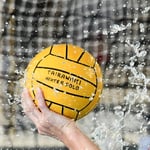Rules
Flippa Ball Play
- To start the game, players line up along their respective goal line. At the referee’s whistle, the referee drops the ball in the middle of the pool and players move to the centre line. Position is granted to the team who reaches the ball first. The first pass must be backwards to a team mate.
- A goal is scored when the whole ball crosses the line of the front 2 posts (the ball does not need to touch the back of the net). The ball carrier can only shoot when they are in the attacking half of the court. It is not permissible to shoot from one’s own half.
- To start play after a goal is scored, players from each team must return to their own half. The ball starts at halfway with a player from the team who did not score the goal. On the referee’s whistle, the player with the ball must pass backwards to a team mate and then the game will continue.
- A corner throw (taken from beside the red 2 metre cone) will be awarded if the ball is knocked out of play by a defending player or goalie.
Free Throw Infringements
- All of the infringements below will result in a free throw being awarded by the referee:
- A player cannot contact the ball with 2 hands (exception being the goalie)
- A player cannot take the ball under the surface of the water
- A player cannot walk or run with the ball
- A player cannot hit the ball with a closed fist
- A player cannot swim on or over an opponent’s legs
- A defensive player cannot contact an attacking player
- An offensive player cannot fend away a defensive player.
- Offside play
Additional Rules
- Players not in game are to sit on the team bench or designated bench area. Players are not to wear items such as jewellery, goggles, glasses or anything that could cause harm or injury to another player or yourself.
- During the game coaches must be situated in the corner of the pool where their team is located and can only move between that corner of the pool (up to the 2m cone) and the goal that his/her team is defending.
- Players can use only one hand to catch, pass, shoot or defend the ball. The exception to this is the goalie, who may use both hands.
- The pool is shallow, (approximately 1 metre) allowing players to stand on the bottom of the pool. Players are permitted to walk along the bottom if they do not have the ball. However, if in possession of the ball the player must swim or pass.
- A player cannot take the ball under the surface of the water. Note that the player whose hand is closest to the ball will be the player deemed to have taken the ball under.
- A player cannot swim on or over an opponent’s legs, a defensive player cannot contact an attacking player, an offensive player cannot fend away a defensive player – if this occurs, a minor foul/ free throw is awarded.
- NO Splashing, sinking, holding or pulling back- or a major foul/ exclusion for 20 seconds will be enforced.
- No aggressive play (striking or attempting to strike another player) or use of abusive language – this results in exclusion for the remainder of the game with a substitute at the referee’s signal.
- When 2 players simultaneously gain possession of the ball, the referee will signal a neutral throw. The 2 players involved face the referee, close to the side of the pool, same side as their goalie, the referee then blows the whistle and throws the ball high in the middle of the 2 players, who attempt to gain possession by jumping and tapping the ball to the player on their team.
- Holding the ball under the elbow (or in the crook of the arm) when tackled by a defender, is a foul with possession being awarded to the opposing team.

